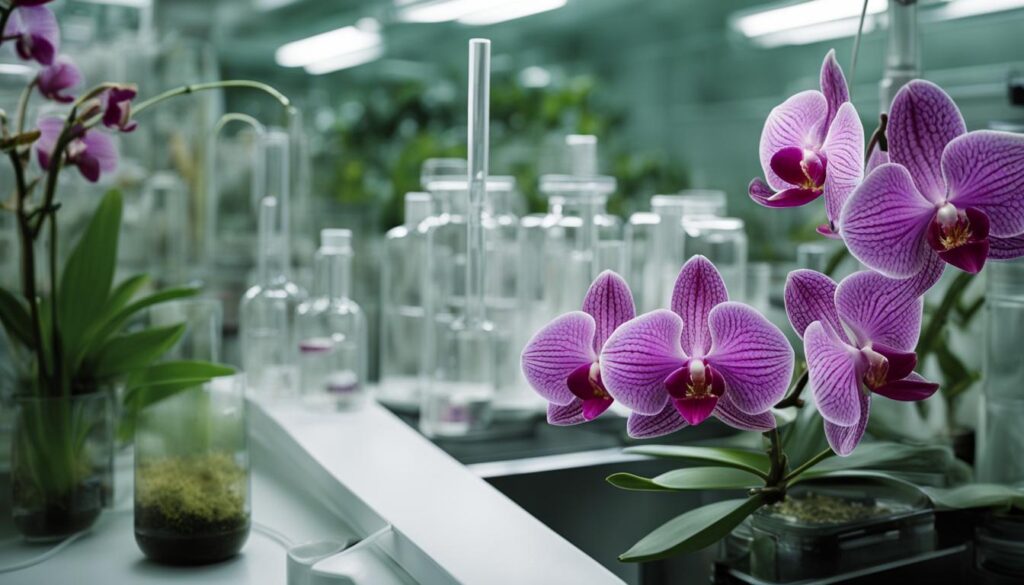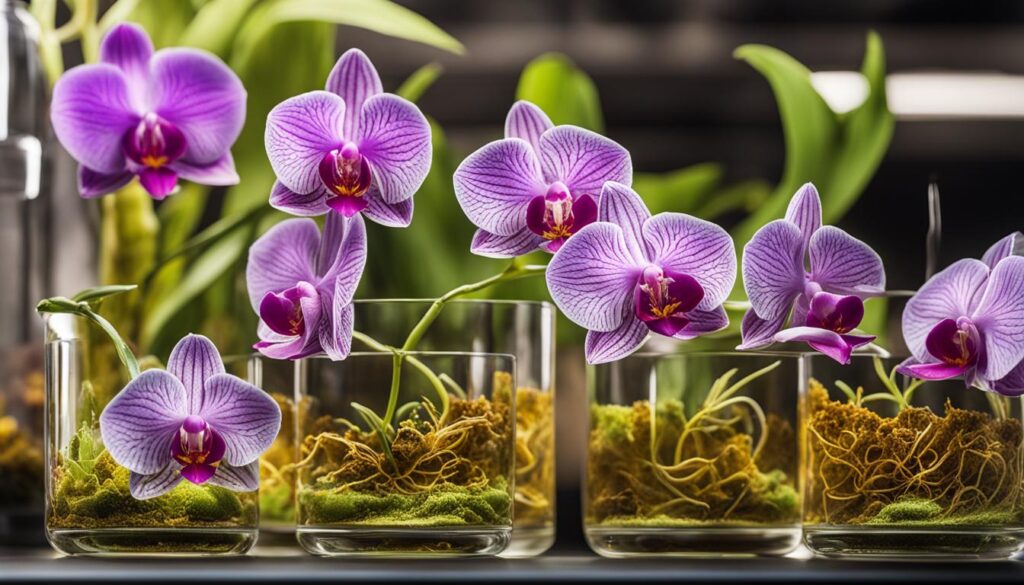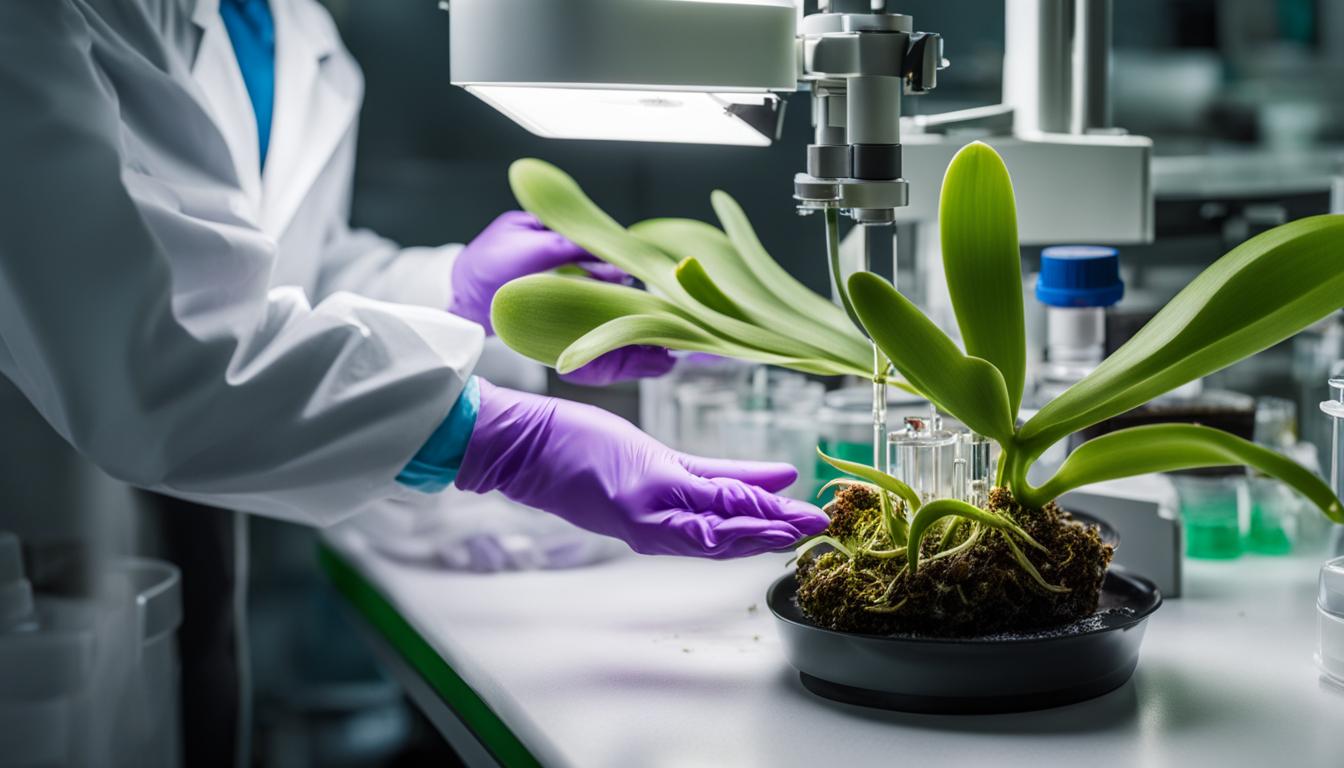As an avid cultivator and researcher of orchid propagation, I have been deeply immersed in the intricacies of orchid meristem tissue culture.
This technique stands as a cornerstone of modern horticulture, significantly advancing the micropropagation of orchids. Through it, we can not only propel the production of these magnificent plants but also maintain their genetic purity, which is essential for both commercial growers and enthusiasts alike.
By honing in on the source of explants and optimizing plant tissue culture techniques, I aim to enhance the proliferation of protocorm-like bodies.
These are pivotal to successful orchid cloning, particularly for highly revered Dendrobium orchids.
My commitment to refining these processes is driven by the potential to vastly improve sustainability and efficiency in the field of orchid propagation.
Key Takeaways
- Understanding of orchid meristem tissue culture is vital for efficient orchid propagation.
- Refining explant sources and methods increases the efficacy of clonal propagation.
- The commercial applicability of meristem culture can be enhanced for various orchid genera, especially Dendrobium.
- Meristem culture is integral for achieving virus elimination and asexual propagation in orchids.
- Continuous innovation and research are key to advancing micropropagation techniques.
- Promotion of genetic fidelity and mass multiplication of orchids is at the heart of modern tissue culture.
Understanding the Basics of Orchid Meristem Tissue Culture
As we delve into the intricate world of plant tissue culture, it’s important to comprehend the pivotal role it plays in modern horticulture, especially for orchids.
This method allows for precise control over the growing conditions, resulting in improved plant health and increased propagation rates.
One key aspect of this technique, known as meristem culture protocol, enables the orchid growers to produce large quantities of uniform and disease-free plants.
The Role of Meristem in Orchid Propagation
Meristem culture exploits the cells in the meristematic region of a plant – the site of active cell division.
In my experience with orchid tissue culture protocol, these undifferentiated cells, particularly in the shoot tips, are responsible for generating the entire plant.
This makes meristem culture an essential tool for cloning orchids, ensuring genetic fidelity to the parent plant, which is a critical aspect for maintaining the desirable traits in commercial orchid varieties.
Types of Tissue Culture Techniques and Their Application
- Embryo Culture: Used to prevent developmental abortion and overcome seed dormancy, ensuring successful germination.
- Tissue Culture: Encompasses various techniques for plant cell, tissue, and organ culture, aiming at plantlet regeneration.
- Shoot Tip or Meristem Culture: Focuses on growing plants from the apical meristem, resulting in virus-free clones, as shown in crops like potatoes. In orchids, this technique is vital for the clonal propagation of high-quality blooms.
Historical Insights: The Advent of Orchid Tissue Culture Protocols
The history of plant tissue culture is rich with milestones that have shaped the way we propagate plants today.
The achievements in orchid tissue culture began with species like Cymbidium and Dendrobium, which were among the first to benefit from this technology.
This paved the way for what is now a standardized meristem culture protocol that we see in use across the globe.
The implications for commercial propagation are substantial, allowing for mass production of these captivating plants to meet the demands of markets and enthusiasts alike.
The Importance of Aseptic Conditions and Sterilization
As I delve into the world of orchid cloning and meristem culture, the non-negotiable rule is establishing and maintaining aseptic conditions to ensure success.
The process starts with the careful selection and disinfection of plant tissues, actions that are critical to the integrity of our plant tissue culture media.
It’s a meticulous endeavor that involves a team of dedicated specialists, working in unison to safeguard our cultures from contamination.
Preparing Plant Tissue for Culture: Disinfection and Explant Selection
When I harvested new shoots from Dendrobium phalaenopsis hybrids, I chose them based on their robust flowering patterns.
These shoots served as explants, originating from leadbulbs or backbulbs. It was imperative that these explants went through rigorous disinfection with antiseptic solutions, which was immediately followed by several rinses in sterile distilled water.
Only then could they be introduced to the plant tissue culture media.

Maintaining Contamination-Free Environments in Lab Settings
As I reflect on the painstaking measures taken to ensure contamination-free environments, it becomes clear that every successful tissue culture owes its existence to the unsparing efforts to aseptically control the lab settings.
This attention to detail is the bedrock on which the sterility of the entire meristem culture relies.
Effective Sterilization Techniques for Orchid Tissue Culture Media
In the preparation of our plant tissue culture media, I specifically focus on effective sterilization techniques.
This involves not just the sterilization of the media itself but all the containers and instruments that come into contact with it.
| Technique | Purpose | Common Application |
|---|---|---|
| Autoclaving | Sterilize media & equipment | Orchid tissue culture preparation |
| Filtration | Remove bacteria and fungi from liquids | Sterilizing heat-sensitive solutions |
| Chemical Disinfection | Surface sterilization of explants | Preparation of explants for meristem culture |
In conclusion, every step taken toward maintaining aseptic conditions and thorough sterilization directly contributes to the outstanding quality and health of our orchid cultures.
It’s this unwavering commitment to excellence that paves the way for successful meristem culture and orchid cloning endeavors.
Orchid Meristem Tissue Culture Media and Growth Regulators
As I delve deeper into the intricacies of orchid tissue culture media and plant growth regulators, it’s clear that these components are pivotal in the success of orchid culture.
Their formulation and interaction with plant tissues drive the efficiency of meristem culture, playing a crucial role in the development of healthy, robust orchids.
Let’s explore the vital components and enhancements in media and regulators that support superior tissue development.
Composition and Significance of Orchid Tissue Culture Media
The right blend of nutrients and support substrates in orchid tissue culture media determines the health and growth of the cultured plantlets.
This medium is engineered to simulate the optimal growing conditions that orchids would find in their natural habitat.
It’s not just a matter of providing a sterile environment for growth; it’s about crafting the perfect balance that stimulates and sustains development.
Optimizing Hormonal Combinations for Enhanced Growth
In my experience, combining different plant growth regulators can either make or break the culture.
Whether it’s auxins, cytokinins, or gibberellins, each regulator plays a key role in cellular differentiation and overall growth.
By fine-tuning the concentrations of these hormones in the media, I’ve witnessed significant improvements in both the quality and quantity of orchid propagation.
Influence of Chemicals Like Chitosan on Orchid Tissue Development
One cannot overlook the emerging role of chitosan in plant tissue culture techniques. Its addition to the media has been a game-changer in my efforts to enhance plantlet vigor and disease resistance.
The biopolymer acts as an elicitor to trigger defense mechanisms within plant tissues, paving the way for a new generation of growth media formulations.

Below is a table that summarizes the effects of chitosan when added to standard orchid tissue culture media:
| Parameter | Control (Without Chitosan) | With Chitosan |
|---|---|---|
| Growth Rate | Standard | Enhanced |
| Disease Resistance | Moderate | Improved |
| Root Development | Normal | Robust |
| Overall Plantlet Health | Good | Superior |
The results reveal that integrating chitosan into the culture medium is not just beneficial, it’s transformative.
When I compare my cultures grown on standard media with those containing chitosan, the latter consistently outperforms the former, especially in terms of growth rate and overall plantlet health.
It’s compelling to consider how chitosan is reshaping plant tissue culture and the propagation of orchids.
Advanced Techniques in Orchid Meristem Tissue Culture
As I delve deeper into the realm of orchid tissue culture protocol, I am particularly intrigued by the progressive strides in advanced plant tissue culture techniques.
These innovations foster amplified growth and bolster the propagation process, ensuring that orchids can be mass-produced to meet market demand.
An example of such advanced methodology is the temporary immersion system (TIS), which elegantly combines timed immersion of plant tissues in the nutrient solution, with periods of draining, thus optimizing exposure to air and nutrients without oversaturation.

Key to the advancement in orchid tissue culture protocol is the implementation of bioreactor technology.
Bioreactors, especially those that are air-driven, support the uniform distribution of nutrients and gasses, facilitating more efficient mass micropropagation of orchid protocorm-like bodies than ever before.
This technology mirrors the plant’s natural environment more closely, paving the way for healthier and more robust plantlets capable of adaption to their permanent environment post-culture.
The nuances of light exposure and the modalities of introducing natural ventilation into the culturing process cannot be understated. Controlling light quality, for example, influences the photosynthesis pathways directly, affecting plant growth at the cellular level.
Furthermore, the use of natural ventilation mitigates the risk of contamination, a persistent challenge in meristem tissue cultures, while also promoting more vigorous growth patterns.
In this pursuit, I am reminded of the words of the renowned botanist Dr. Carol Stiff: “Bridging the gap between laboratory and greenhouse is where the future of orchid propagation lies.”
To actualize Dr. Stiff’s vision, I’ve noted innovations like the periodic immersion bioreactor, which integrates cyclic submersion of tissue in the culture media, ensuring consistent nutrient uptake and thus, healthy plant development.
This meristem culture protocol advancement exemplifies the meticulous effort to refine regenerative practices in the propagation of orchids.
As we continue this journey of exploration and innovation, it’s evident that these advanced plant tissue culture technologies are not just a boon to the horticultural industry but are setting the stage for breakthroughs in the way we cultivate and preserve the genetic diversity of these ethereal blooms.
Conclusion
As we encapsulate the strides made in the world of horticulture, I’m compelled to highlight the breakthroughs in the micropropagation of orchids. The adaptability and refinement of the meristem culture protocol have not merely enhanced the art and science of breeding these plants but have also cemented their vital role in orchid propagation.
The advancements dove into throughout this article spell out a journey of meticulous experimentation and discovery, unveiling the transformative possibilities within orchid tissue culture media compositions and methodologies.
It’s clear that the incorporation of chitosan into these processes, married with the rigorous application of sterilization techniques, has yielded fruit in terms of improved health and multiplication rates of orchid cultures.
Moreover, the push towards leveraging advanced techniques promises exciting avenues for the mass multiplication of orchids, ensuring the preservation of genetic integrity within these micropropagated marvels.
As I delve into this intricate tapestry, the evolution of tissue culture techniques reveals itself as a testament to human ingenuity and ceaseless inquiry.
The orchid’s delicate dance between conservation and commerce continues to inspire. With the knowledge and insights shared here, I am assured of the pivotal role the meristem culture protocol plays within biotechnological and horticultural industries.
The information distilled points to a future ripe with potential, where our collective efforts align to nurture and expand the realms of orchid cultivation, a pursuit rightfully deserving of attention and admiration.
FAQ
What is Orchid Meristem Tissue Culture?
Orchid meristem tissue culture is a technique used to propagate orchids asexually by cultivating the plant’s meristem tissue in a controlled, sterile environment.
Why is the Meristem Used for Orchid Propagation?
The meristem is the region of a plant where active cell division occurs, allowing for the production of identical clones of the original plant, which is crucial for mass propagation and maintaining genetic consistency.
What are the Various Types of Tissue Culture Techniques?
Plant tissue culture can be categorized into embryo culture, tissue culture, and meristem or shoot tip culture, each serving a unique purpose in horticulture and plant propagation.
How Did Orchid Tissue Culture Protocols Develop Historically?
Orchid tissue culture protocols developed from the need to mass-propagate orchids for commercial purposes, which began with the successes in culturing species like Cymbidium and Dendrobium.
Why Are Aseptic Conditions Crucial in Tissue Culture?
Aseptic conditions prevent contamination from microorganisms which could otherwise compromise the growth and development of the plant tissues being cultured.
How are Explants Prepared for Orchid Tissue Culture?
Explants are prepared by selecting healthy plant tissues, disinfecting them with antiseptic solutions, and then rinsing them in sterile water to remove any potential contaminants.
What is the Role of Sterilization in Orchid Tissue Culture Media?
Sterilization ensures that the culture media is free from any pathogens, allowing the explants to grow without the threat of disease or competition from other microorganisms.
What Constitutes Orchid Tissue Culture Media?
Orchid tissue culture media is a nutrient-rich solution or gel that provides the necessary support for orchid growth and development, often supplemented with hormones and other growth regulators.
How are Growth Hormones Optimized in Orchid Tissue Culture?
Growth hormones are optimized in orchid tissue culture by experimenting with different hormonal combinations and concentrations to achieve the best possible growth outcomes for the specific orchid species being cultured.
What Impact Does Chitosan Have on Orchid Tissue Development?
Chitosan has been shown to stimulate growth, enhance resistance in roots, and promote the induction of differentiation in orchid plant tissues, making it a valuable addition to orchid tissue culture protocols.
What are the Advanced Techniques in Orchid Meristem Tissue Culture?
Advanced techniques include the use of temporary immersion systems, bioreactor technology, and strategies that enhance natural ventilation and light quality, all of which can improve protocorm development and plantlet growth.


Leave a Reply